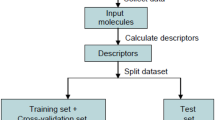Abstract
A three-dimensional quantitative spectrometric data-activity relationship (3D-QSDAR) modeling technique which uses NMR spectral and structural information that is combined in a 3D-connectivity matrix has been developed. A 3D-connectivity matrix was built by displaying all possible assigned carbon NMR chemical shifts, carbon-to-carbon connections, and distances between the carbons. Two-dimensional 13C-13C COSY and 2D slices from the distance dimension of the 3D-connectivity matrix were used to produce a relationship among the 2D spectral patterns for polychlorinated dibenzofurans, dibenzodioxins, and biphenyls (PCDFs, PCDDs, and PCBs respectively) binding to the aryl hydrocarbon receptor (AhR). We refer to this technique as comparative structural connectivity spectral analysis (CoSCoSA) modeling. All CoSCoSA models were developed using forward multiple linear regression analysis of the predicted 13C NMR structure-connectivity spectral bins. A CoSCoSA model for 26 PCDFs had an explained variance (r2) of 0.93 and an average leave-four-out cross-validated variance (q4 2) of 0.89. A CoSCoSA model for 14 PCDDs produced an r2 of 0.90 and an average leave-two-out cross-validated variance (q2 2) of 0.79. One CoSCoSA model for 12 PCBs gave an r2 of 0.91 and an average q2 2 of 0.80. Another CoSCoSA model for all 52 compounds had an r2 of 0.85 and an average q4 2 of 0.52. Major benefits of CoSCoSA modeling include ease of development since the technique does not use molecular docking routines.
Similar content being viewed by others
References
Thomas, V. and Spiro, C., Toxicol. Environ. Chem., 50 (1995) 1.
Brzuzy, L.P. and Hites, R.A., Environ. Sci. Technol., 30 (1996) 1797.
EPA: Polychlorinated Biphenyls; Criteria Modification; Hearings. Federal Register, 44 (1979) 31514.
Safe, S., Crit. Rev. Toxicol., 21 (1990) 50.
Mekemyan, O.G., Veith, G.D., Call, D.J. and Ankley, G.T., Environ. Health Perspect., 104 (1996) 1302.
Bhandiera, S., Sawyer, T., Romkes, M., Zmudzka, B., Safe, L., Mason, G., Keys, B. and Safe, S., Toxicology, 32 (1984) 131.
Mason. G., Farrell, K., Keys, B., Piskorska-Pliszczynska, J., Safe, L. and Safe, S., Toxicology, 41 (1986) 21.
Mason. G., Sawyer, T., Keys, B., Bandiera, S., Romkes, M., Piskorska-Pliszczynska, J., Zmudzka, B. and Safe, S., Toxicology, 37 (1985) 1.
Bandiera, S., Safe, S. and Okey, A. B., Chem.-Biol. Interact., 39 (1982) 259.
Beger, R.D. and Wilkes, J.G., J. Comput.-Aid. Mol. Des., 15 (2001) 659.
Beger, R.D. and Wilkes, J.G., J. Chem. Inf. Comput. Sci., 41 (2001) 1360.
Beger, R.D. and Wilkes, J.G., J. Chem. Inf. Comput. Sci., 41 (2001) 1322.
Andersson, P.L., van der Burght, A.S.A.M., van der Berg, M. and Tysklind, M., Environ. Toxicol. Chem., 19 (2000) 1454.
Bursi, R., Dao, T., van Wilk, T., de Gooyer, M., Kellenbach, E. and Verwer, P., J. Chem. Inf. Comput. Sci., 39 (1999) 861.
Turner, D.B., Willett, P., Ferguson, A.M. and Heritage, T., J. Comput. Aid. Mol. Des., 11 (1997) 409.
Beger, R.D., Buzatu, D.A., Lay, J.O. and Wilkes, J.G., J. Chem. Inf. Comp. Sci. 42 (2002) 1123.
Beger, R.D. and Wilkes, J.G., J. Molec. Recognit., 15 (2002) 154.
Silverman, B.D. and Platt, D.E., J. Med. Chem., 39 (1996) 2129.
Aue, W.P., Bartholdi, E. and Ernst, R.R., J. Chem. Phys., 24 (1976) 2229.
Jeener, J., Meier, B.H., Bachmann, P. and Ernst, R.R., J. Chem. Phys., 71 (1979) 4546.
Beger, R.D. and Bolton, P.H., Biol. Chem., 273 (1998) 15565.
Beger, R.D. and Bolton, P.H., J. Biomol. NMR, 10 (1997) 129.
Wishart, D.S. and Sykes, B.D., Meth. Enzymol., 239 (1994) 363.
ACD/Labs CNMR software version 5.0, Toronto, Canada.
Poland, A. and Knutson, J.C., Annu. Rev. Pharmacol. Toxicol., 22 (1982) 517.
Poland, A., Glover, E. and Kende, A.S., J. Biol. Chem., 251 (1976) 493.
Safe, S. Crit. Rev. Toxicol., 13 (1984) 319.
Safe, S.H. Annu. Rev. Pharmacol. Toxicol., 26, (1986) 371.
Bremser, W. HOSE – a Novel substructure Code. Anal. Chim. Acta., 103 (1978) 355.
Statisica, StatSoft software, Tulsa, OK.
Cramer, R.D., Bunce, J.D. and Patterson, D.E., Quant. Struct.-Act. Relat., 7 (1988) 18.
Mekemyan, O.G., Veith, G.D., Call, D.J. and Ankley, G.T. Environ. Health Perspect., 104 (1996) 1302.
Rannug, U., Sjogren, M., Rannug, A., Gillner, M., Toftgard, R., Gustafsson, J.-A., Rosenkranz, H. and Klopman, G., Carcinogenesis, 12 (1991) 2007.
Kafafi, A.A., Afeefy, H.Y., Said, H.K. and Hakimi, J.M., Chem. Res. Toxicol., 5 (1992) 856.
Cho, S.J. and Tropsha A., J. Med. Chem., 38 (1995) 1060.
Author information
Authors and Affiliations
Rights and permissions
About this article
Cite this article
Beger, R.D., Buzatu, D.A. & Wilkes, J.G. Combining NMR spectral and structural data to form models of polychlorinated dibenzodioxins, dibenzofurans, and biphenyls binding to the AhR. J Comput Aided Mol Des 16, 727–740 (2002). https://doi.org/10.1023/A:1022479510524
Issue Date:
DOI: https://doi.org/10.1023/A:1022479510524




